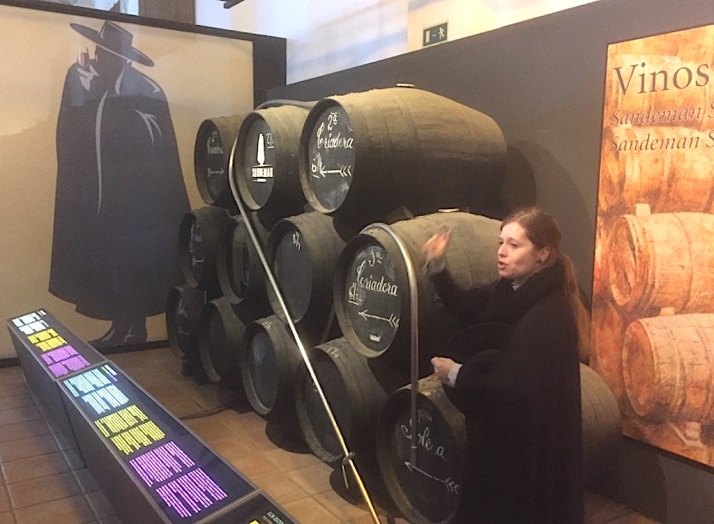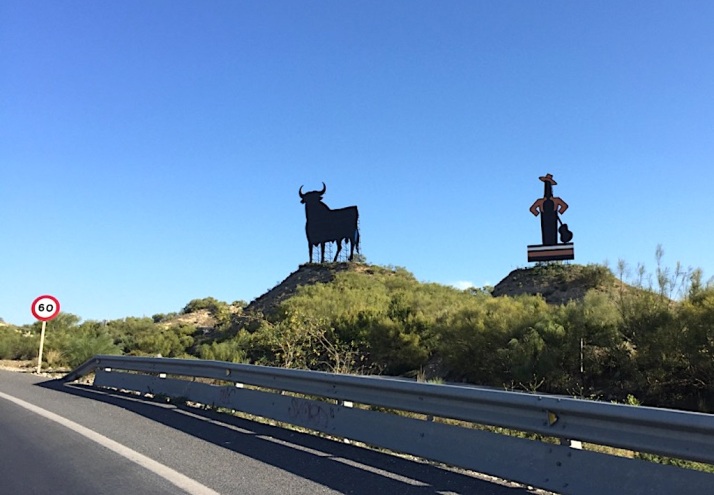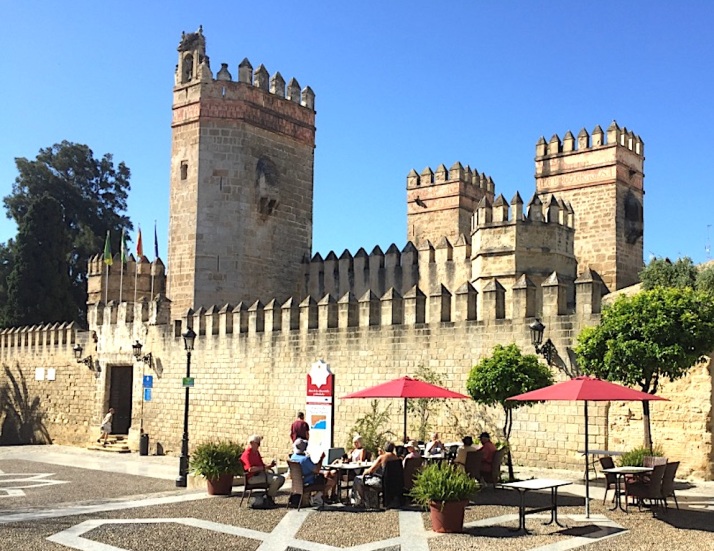In a small three-sided area of calcareous soils in southern Spain, white palomino grapes grow-up to be sherry wines. To “research” and taste these curious wines, we triangulated in our rental car to the towns of Jerez de la Frontera (Jerez), Sanlúcar de Barrameda (Sanlúcar), and El Puerto de Santa Maria (El Puerto).

Mural of sherry winemaker sampling from the barrel, Jerez de la Frontera
Our introduction to sherry wine launched in the town of Jerez. Etymologically, the name “Jerez” comes from the Muslim word “Scheris”, from which the word “sherry” is also derived. Jerez is a classic southern Spanish town known for its flamenco music, Andalucian horses, and numerous sherry bodegas.

Tio Pepe, the “Badass” little bottle of sherry wine
Jerez is home to the renowned González Byass bodega and its celebrated brand of dry fino sherry Tio Pepe. With his wide-brimmed red hat, red bolero jacket, and flamenco guitar, Tio Pepe (Uncle Joe) is one of the most recognizable advertising figures in Spain.

Learning about the solera aging process at Sandeman
For a tour and tasting, we skipped the crowds at Gonzâlez Byass and instead visited the “Don” and the House of Sandeman. Inside Sandeman, our black-caped tour guide introduced us to the basics of sherry wine, including the all-natural winemaking processes that employ old American Oak barrels and an exclusive and complex “solera” aging process.

Four Sherry Wines
The informative tour concluded with the tasting of four sherry wines. By fortifying sherry with added alcohol, dry varieties are created from golden-yellow fino to amber amontillado and oloroso. Additional sweet sherry wines are made by adding the sugary raisin wines of Muscatel and Pedro Ximénez.

Palominio vines in white calcareous soil near Sanlúcar de Barrameda
Following an isosceles course, we continued our sherry wine education in the seaside town of Sanlúcar. At this location, where the Guadalquivir River drains into the Atlantic Ocean, the 1519 Magellan expedition to circumnavigate the Earth embarked 500 years ago, and barely returned full-circle three years later.

Barbadillo’s “Cathedral” aging house
In Sanlúcar, we called on the Barbadillo Bodega, the largest producer of manzanilla sherry. Manzanilla is a tangy and salty fino sherry only produced in the coastal climate of Sanlúcar. It is aged in dark, naturally-ventilated, cathedral-like warehouses, which promotes thick yeast layers inside the barrels that protects the wine from oxidization.

Osborne Bull and Tio Pepe roadside signs between El Puerto and Jerez
From Sanlúcar, we navigated back to El Puerto, our home port for the month of April. El Puerto is also the origin of Osborne Bodegas and the Osborne Bulls, a series of 91 billboards throughout Spain of silhouetted black bulls standing an imposing 46 feet (14 meters) tall.

Castillo San Marcos in El Puerto de Santa María (note stork nest)
To taste the sherries of El Puerto, we visited Castillo San Marcos, a restored 13th century castle now owned by Bodegas Caballero. Inside the castle, Columbus conceived the route to the Indies. Later, the cartographer Juan de la Cosa, owner of the flagship Santa María, made the first map of the New World here.

Presentation of sherry wines in Castillo San Marcos
By following our own map, we successfully circumnavigated the three-sided route between Jerez, Sanlúcar, and El Puerto. Along the way, we discovered a unique winemaking process and acquired a taste for the unusual and diverse varieties made exclusively within the Sherry Triangle.

Uncle Joe (Tio Pepe) still standing straight outside González Byass

Growing up, my grandmother would come and stay with our family for extended periods. Each night it was my Dad’s job to get Nana her pre-dinner Australian dry sherry. I loved your account of visiting the sherry bodegas and thank you for causing me to pause and remember my dear Dad and my Nan.
LikeLiked by 1 person
Hi Sue & Dave, I am happy that my ramblings brought back such fond memories of your dear father and grandmother’s pre-dinner routine. The dry fino and manzanilla sherries are an excellent aperitif, and are enjoyed before meals here in Spain too. Cheers!
LikeLike
Joe, such a lovely journey through the history of sherry wine in this region of Spain. I did see the black bull billboards on the top of the hills when we traveled through this area few weeks ago…and I wondered what they were, now I know…thank you. We were heading for Portugal. I like sherry, but did not realise there are so many different varieties and colours. Very interesting, thank you 😄
LikeLiked by 1 person
I’m happy you learned a little bit about sherry from the post, Gilda. I learned a lot about this interesting winemaking process, and thoroughly enjoyed “researching” the various varieties. The 91 Osborne Bulls are scattered all around Spain. The province of Cádiz has ten, which is the most. Driving around the province, I think I have spotted five of them. I wonder how many you have seen on your motorhome journey?
LikeLike
I think we seen 3 🙂
LikeLiked by 1 person
Hi. I’m mostly a beer drinker. Never had sherry. The one Spanish wine I’ve had is alberino. Liked it a lot. See ya!
Neil
LikeLiked by 1 person
Hi Neil, I am usually a beer drinker too, and hardly ever have wine at home. I have not heard of alberino, but will ask for it next time. I was attracted to sherry wine because of its range of flavors from dry and tangy to syrupy sweet. As a bonus, I found the winemaking process very interesting. Cheers!
LikeLiked by 1 person
Definitely try the Alberino, Joe. It’s my “secret” favorite to introduce to people when they say they hate white wines (i.e. chardonnay usually). I’ve had a love affair with Spanish wines for years now. Franco put his boot heels on the industry during his reign, but it’s now definitely some of the best in the world. I will be sure to check out their sherry someday soon. – Marty
LikeLiked by 1 person
Thanks for the tip, Marty. Now that a second trusted friend has recommended Alberino wine, I will sharpen my eye to see if I can sample it before we leave Spain. If not, I am sure that our local wine warehouse in Reno will have it. I’m thinking of throwing a party when we get home, and serving some of the Spanish food and wines that we have discovered. Please stop by if you are in the neighborhood!
LikeLiked by 1 person
And, of course, don’t forget those wonderful reds like Tempranillo and Grenache. I’d love to come! 😃
LikeLiked by 1 person
The things you put yourself through in the pursuit of science! I love that the flavors varied so much… even a salty one! I enjoy wine and I love having a good port now and then, but I don’t know much about sherry. Thanks for the intro!
LikeLiked by 1 person
Haha! Being a scientist does have its drawbacks. You will find sherry all over Spain, especially in the south. If you try the dry fino sherry, don’t be put off by the strong initial taste. By your second glass, you will probably be a sherry lover for life. You will also catch a bit of a buzz, given sherry’s alcohol content of 15-18%. Cheers!
LikeLike
What fun! I can’t imagine how cool it must be to get to do a sherry tasting in Spain. The only sherry I ever tasted was far too sweet, so I’m intrigued to know that there are so many varieties of dry sherry as well. And I’m ashamed to say I never even realized that Sherry came from Spain. I had always associated it with England for some reason!
LikeLiked by 1 person
Hi Ann, It has been fun exploring and sampling this interesting wine country. Your confusion is understandable, given that the English have been importing Spanish sweet sherry for centuries. They are tasty, but my favorite is the dry manzanilla from Sanlúcar. Most people recoil after the first sip, because it is really salty, yeasty, and tangy. Once your taste buds acclimate; however, it is a precariously habit-forming libation.
LikeLiked by 1 person
So here we are, just back from 10 days in Jordan, probably our first completely alcohol free holiday ever, and we get home and decide to push it through to Easter – well, tomorrow night – to do a clear two weeks clean. And what happens next? Joe does a boozeblog!!!
LikeLiked by 1 person
Yikes! I hope it didn’t knock you off the wagon. I am amazed and impressed with your tenacity and staying power. While you were exploring the mysterious Middle East, I was sipping sherry without restraint. As a result, I have fallen way behind on my reading. I am excited to read about your adventures, as soon as I sober up. Happy Easter!
LikeLike
It’s ok, the silly season is over and English ale is back on the agenda now. We’re big fans of Spanish reds by the way, and there are plenty of good ones. If you tried some in Valencia, no doubt you noticed that they keep it chilled (!) and are amazed when you say “no frio por favor”.
LikeLiked by 1 person
No hang on – the chilled red wine was Sevilla, not Valencia….
LikeLiked by 1 person
I know it is hard to keep all of the Spanish wines straight, especially after a few glasses. A chilled red wine on a hot day in Sevilla sounds perfect.
LikeLike
Can’t say I’ve ever been a sherry drinker, although I have cooked with it. I suspect what I’ve been cooking with may not be the best for drinking.
About the only Spanish wine I’m familiar with is Rioja. That region looks to be well north of where you’re at, not sure if you’ll end up there.
LikeLiked by 1 person
I always enjoy your insights, Dave. As you know, Rioja is a wine region in northern Spain that mostly produces popular and plentiful tempranillo red wines. We visited the Rioja region last fall during our month in the Basque Country. Cooking sherry is a valuable tool in the kitchen. It is good to drink, but contains added preservatives to prevent oxidation. The best dry sherries for drinking like fino and manzanilla are light golden-yellow, best served chilled, and have very short shelf-lives. Cheers!
LikeLiked by 1 person
This was fascinating, Joe! As much as I enjoy wine, would you believe I’ve never tasted Sherry? Mostly because I don’t like sweet wines and I’m always afraid of getting the wrong type. 🙄
LikeLike